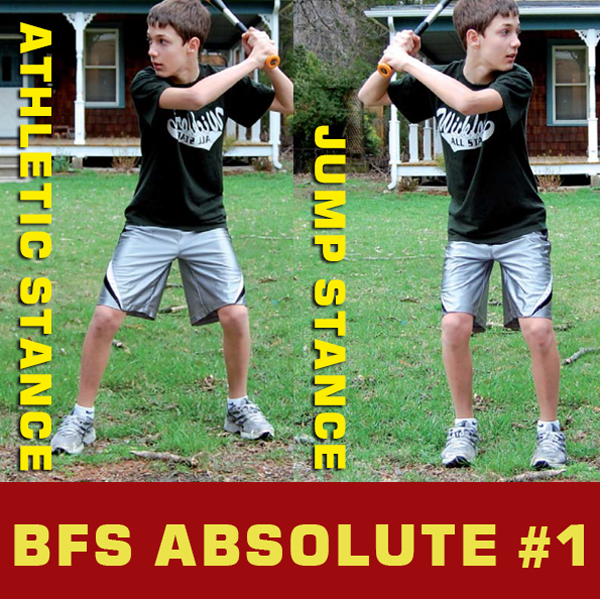Start Strong! BFS Absolute #1 - Stance

When preparing to hit a baseball, David Kandel shows that an athletic stance (left) provides a more stable base than a jump stance (right).
By Kim Goss,
Originally Published May, 2010
It’s the shoes!” is a popular advertising slogan that suggests there must be some special quality in a pair of athletic shoes that makes one athlete superior to another. It’s an effective slogan, no doubt, as kids (or rather, their parents) are willing to spend over $100 for a pair of sneakers that promise to give them athletic superiority along with the latest style sense. But the truth is that success in athletics doesn’t depend so much on what you put on your feet as to where you put them.
All sports require the use of one or both of the same two basic foot stances, a jump stance, and an athletic stance. Collectively, we refer to this as the first absolute of the Six Absolutes of Perfect Technique, which is “Use an Athletic or Jump Stance.”
A jump stance is the position where the feet are directly under the hips. How far the feet are apart depends upon the height of the individual, but as a general guideline say six to eight inches. This is the best stance for generating speed and jumping power. An athlete would use this type of stance when performing a vertical jump or during the start of a power clean or a deadlift. One reason that the jump stance is the best foot stance in these situations is that were the feet too wide apart, much of the force generated from the ground would be dispersed horizontally, reducing strength, power, and speed. You can prove this by simply testing your vertical jump. If you don’t have a Just Jump and Run force platform, there is a simple alternative. Put some chalk on your fingertips, stand near a wall with your feet wider than shoulder-width apart, and see how high you can jump – touching the wall at the highest point of the jump. Then use a jump stance and notice the difference.
In an athletic stance, feet are approximately shoulder-width apart – again, the exact distance depends upon the individual, but as a general guideline, it will be about six to 10 inches wider than the jump stance. To understand why this stance is important, you need to understand such concepts as the center of gravity, stability, and base of support.
Download the Free 6 Absolutes Book
An athlete’s center of gravity, or center of mass, is not necessarily the bellybutton. It’s the single point on the body where the athlete’s body mass is equally distributed between the head and the toes. You’ve probably heard of how a basketball player will bend their knees as they jump to manipulate their center of gravity, giving the illusion of greater hang time. Well, it also works in the opposite way. By widening the distance between the feet, an athlete lowers their center of gravity, which in turn increases their stability.
What further increases the stability is that moving the feet out increases the base of support of the athlete, which is the area underneath and between the feet. The wider the base of the support, within reason, the greater the stability. As such, the narrower base of support of the jump stance makes it less stable, and it’s easier for the athlete to be thrown off balance.
In sports, often the athlete alternates between a jump stance and an athletic stance. For example, in a power clean or squat clean, the athlete starts with a jump stance to impart the maximum force on the bar and then moves their feet outward into an athletic stance to catch the weight, as this is a more stable position.
In tennis, a player serves with a jump stance to generate maximum power on the ball, but the athlete on the other side of the net will be in an athletic stance to increase their stability and therefore their control when the ball hits their racquet. In the area of strength and conditioning, the basic concept here regarding the first absolute is to build strength with an athletic stance, and build explosiveness with a jump stance.

Gymnast Chloe Van Tussenbroek (left) shows that the best position for jumping is a jump stance, while softball player Jordon Cedarstrom demonstrates that the best receiving position for a power clean is an athletic stance.
Six Absolute Poster Set on Sale This Week - Save 20% With Code 2019056A
Click to see the 6 Absolutes in action for middle school kids!
Squatting and the 1st Absolute
Let’s take a closer look at how this absolute works in squatting. In squatting, there are three basic squatting stances: bodybuilding, powerlifting, and athletic.
Bodybuilders generally use a very narrow stance, often with the toes straight ahead – essentially a jump stance – and sometimes with a board placed underneath the heels. This method is used to attain certain bodybuilding objectives of increasing development of the teardrop-shaped muscle of the lower thigh called the vastus medialis. In contrast, an Olympic lifter will use more of an athletic stance while squatting, assuming the same position they use when they are catching the weight in the bottom position of a snatch or clean. But what about powerlifting?
Many powerlifters will use a very wide stance with the toes flared out – it’s actually not an athletic stance because it is too wide. Such a stance belongs in its own category unique to the sport – so we’ll call it a powerlifting stance. Although this stance reduces the power from the quadriceps, it enables powerlifters to lift more weight because they reach the parallel position sooner and the lifting action relies more on the powerful glutes and hamstrings. Powerlifters will use whatever stance will allow them to squat the most weight, even though some of these techniques do not have as much carry-over to sports. For example, during box squatting many powerlifting coaches recommended keeping the shins perpendicular to the floor – in what sport do the shins remain perpendicular to the floor? It’s not a natural movement.
Whenever we hear about squatting stances from strength coaches or attend a seminar on the subject, invariably the experts will say, “Take about a shoulder-width stance.” This is meant to be an athletic stance, but is there a better way to refer to the stance? Yes! This is part of your winning edge. Part of “the secret.”
Ask basketball players to get in a rebounding stance and baseball players to look like a shortstop. Tell football players to get in a linebacker stance, and volleyball and tennis players to assume their “ready” position. At T otal Program Camps, a BFS clinician might put an athlete into a bodybuilder’s squatting stance and ask, “Does this look like a linebacker?” The kids should respond, “No. Get your feet wider!” He could then put them into a wide powerlifting stance with the toes flared way out and ask, “How about this position? Does this look like a football, basketball or baseball player?” Then he would get them into an athletic stance, and the athletes saw that the “ready position” for all main-stream high school sports is essentially the same.
When coaching, it is much easier to provide instructions to an athlete by saying “athletic stance” rather than saying “put your feet about shoulder-width apart.” Likewise with the jump stance. Furthermore, in the weight room, you should select the appropriate stance for each specific exercise. And if a school can get all coaches using this terminology, it makes for a smoother transition from sport to sport and there is little confusion about what coaches are trying to teach. The Six Absolutes – it’s biomechanics, and coaching, made simple.
See BFS coaching all Six Absolutes HERE
Read A Closer Look at Absolute #4 and 5 Here
Read A Closer Look at Absolute #3 Here
Read A Closer Look at Absolute #2 Here
Six Absolute Poster Set on Sale This Week - Save 20% With Code 2019056A


Comments
Lonnie Cook said:
Do y’all still sell the computer software that designs weight lifting program for each student.